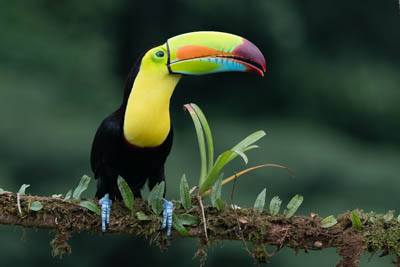Day 1
We began our adventure exploring Costa Rica’s vibrant lower lands. As the guests arrived from the United States to San Jose, Costa Rica they were picked up from the airport and taken to a hotel outside of town that is renowned for its beautiful gardens.
Joining us on the Costa Rica Lowland Photography workshop is Debi from Colorado, Sheila from Texas, Margaret from Arizona and Richard from California. As we all met for dinner, we got to know each other and talked about the exciting days again.
Our discussion this evening was on macro frog photography, as well as using a multi-flash setup to photograph the Long-tongued bats, which are both on our agenda tomorrow.
Day 2
After a nice breakfast of Costa Rican specialties including fresh fruit and juice grown locally, we headed out of town to the North to visit a family that has turned their property into a wildlife preserve. While visiting the preserve we were toured around by the owners who took time to show us all the great photo opportunities that existed.
Below are some of the subjects we photographed:
- Red-eyed tree frogs
- Strawberry poison-dart frog or Blue jean frogs
- Green and black poison dart frog
- Red-legged Honeycreeper
- Clay-colored Thrush
- Blue-gray tanagers
- White-collared Manakin female chick in nest
- White-collared Manakin male displaying and dancing for female
- Collared Aracari
- Scarlet-rumped Tanager
- Grey-necked wood rail
- Grey-headed Chachalaca
- Black-cheeked Woodpecker
- Rufous-winged Woodpecker nesting
- Olive-backed Euphonia nesting in Oropendola nest
- Stripe-throated Hermit hummingbird
- Long-billed Hermit hummingbird
- White-necked Jacobin hummingbird
- Tent-making bats
- Honduran white bats
- Brown long-eared bat in termitary
- Boa constrictor
- Blue Morpho Butterflies
- Owl butterflies
- Two-toed sloth
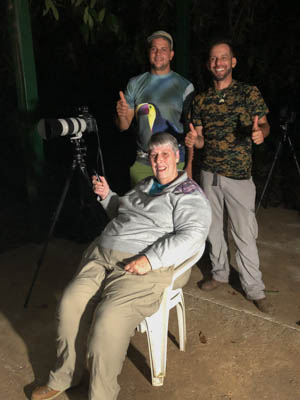
Margaret photographing the Mexican Long-tongued bats at night with our multi-flash setup.
After a full afternoon photographing all the wildlife, we continued our journey North into the rainforest.
As we drove, we saw many Scarlet Macaws in flight near the Sarapiquí. What a beautiful thing to see living so wild.
As we arrived at our next lodge, a beautiful Eco-Lodge in the unspoiled tropical rainforest the toucans (Keel-billed toucan, Black-mandibled toucan and Collared aracari) as well as many other colorful birds were out in great numbers. While the guests were out on the deck photographing them, we quickly setup the multi-flash setup to capture images of the Mexican Long-tongued bats that feed on nectar as the sunset.
Once it got dark, we setup some nice local banana flowers for the bats to feed on. When the bats would fly to the flower, the guests would take their picture as all the flashes would fire at the exact time freezing the bat in flight with its tongue reached out tasting the flower.
Once the activity slowed down, we headed back to the lodge for dinner after a very full day of photography.
Day 3
Today we explored all the rainforest eco-lodge has to offer. The decks and perches have been designed to be at eye-level with the wildlife, so our images will have that engagement that we are looking for.
As the sun rose, we all met on the deck to capture images of the beautiful birds that visit the lodge.
Though the day we photographed the following species:
- Keel-billed Toucan
- Black-mandibled toucan
- Collared Aracari
- Montezuma oropendola
- Brown-hooded parrot
- Red-legged honeycreeper
- Scarlet-rumped Tanager
- Blue-gray tanagers
- Palm tanager
- Scarlet Tanager
- Indigo Bunting
- Great Kiskadee
- Shining Honeycreeper
- Baltimore Oriole
- Black-crowned Tityra
- Scarlet-rumped Cacique
- Euphonia
- Great curassow
- Black-cheeked Woodpecker
- Chestnut-colored woodpecker
- Masked Tityra
- Black-crowned Tityra
- Green Honeycreeper
- Black-cowled oriole
- White-nosed coati
- King vulture
- Turkey vulture
- Black vulture
- Parrot snake
- Fer-de-lance snake
- Eyelash palm pitviper
- Hawk noised pit viper
- Boa constrictor
- Helmet Head Lizard
- Mexican Long-tongued bats
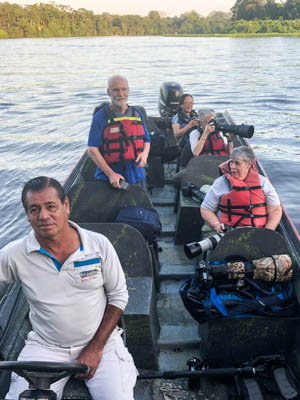
Ready for our early morning photo session at Tortuguero National Park. Debi, Richard, Margaret and Sheila are all ready for wildlife photography
After breakfast we headed on down to photograph vultures at a special blind designed to put photographers at eye level with their subjects. We were very lucky to have great opportunities for the white feathered King vulture. While in the blind we photographed the following vultures:
- King vulture
- Turkey vulture
- Black vulture
The king vultures started fighting and white feathers went flying everywhere as they were jumping up and down attacking each other. What great action shots!
We then stopped for lunch and a little break. After a short rest, we did a macro shoot and had great subjects including a couple of poisonous snakes.
In our macro shoot, we photographed the following.
- Parrot snake
- Fer de lance (very poisonous)
- Eyelash palm pit viper
- Hawk noised pit viper
- Boa Constrictor
- Helmet Headed Basilisk
During the afternoon, we headed back to photograph more of the toucans. Such colorful and photogenic birds.
As night came, we setup the multi-flash setup for the bats and photographed more Long tongue bats on colorful flowers. We had non-stop activity for 2 hours with everyone capturing great images. We then headed back to the lodge for a late dinner and a little sleep.
Day 4
As the sun rose, we continued photographing the Toucans and other colorful birds of Costa Rica. After breakfast we headed to a local farm where the colorful Scarlet macaw, and Great green macaws are common. As we arrived, we setup and photographed these beautiful birds as they perch in the trees and fly from perch to perch.
We had great opportunities as they flew back and forth, and everyone got great Macaw shots. What a beautiful and colorful bird.
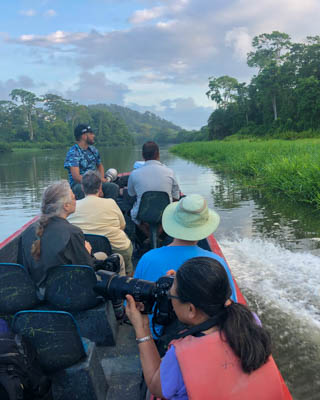
Exploring Tortuguero National Park by boat
We then continued North on our journey to beautiful Tortuguero National Park. Tortuguero National Park, the highlight of the trip, boasts over 77,000 acres with no roads into the park, thus getting here is part of the adventure.
As we arrived at the boat landing, we were met by our boat captain for transport to the remote national park. We wound down the river until we joined the fresh water canals that make Tortuguero National Park famous for its wildlife.
As we wound up the river, we photographed the following species:
- Little blue heron (juvenile)
- Green heron
- Bare-throated tiger heron
- Ringed kingfisher
- Snowy Egret
- Green Basilisk Lizard
- Great green macaw in flight
- Spectacled caiman
- Anhinga
As we arrived at our lodge for the next 3 nights a White-faced capuchin welcomed us as he was mischievously trying to steal bananas from the bar. Once the excitement was over, we checked into our cabanas, had a nice dinner and relaxed after a full day of photography.
Day 5 and Day 6
We spent the next two full days exploring the canals of Tortuguero National Park. Each day we would photograph the wildlife by boat and enjoy the untouched beauty as we cruise the fresh water canals. Over the days we photographed the following species at Tortuguero.
- Spider monkeys
- Howler monkeys with babies on their backs
- White-faced capuchin monkey
- Spectacled caiman
- Green basilisk lizard
- Green Iguana
- Red-webbed tree frog
- Strawberry poison-dart frog
- Snowy egret
- Green heron
- Little blue heron
- Ringed kingfisher
- Anhinga
- Green kingfisher
- Northern jacana
- Sunbittern
- Bare-throated tiger heron
- Purple gallinule
- Green ibis
- Great Kiskadee
- Montezuma oropendola
- Cattle egret
- Great Green macaw
- Lesser long-nosed bats
- Keel-billed toucan
- Red lore parrot
- Black river turtle
- Tricolored Heron
- Black-necked Stilt
- Common Opossum
- Black-throated trogon
- American crocodile
- Amazon Kingfisher
- Laughing Gull
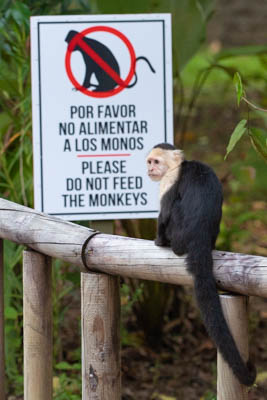
No means No, little monkey. Sorry ! A white-faced capuchin pleads his case for a snack.
On our sixth day of the trip, we ventured through the canals all the way to the Caribbean ocean photographing the wildlife the whole way there.
When not in the boats, we took a little time to photograph some more frogs with our macro light setup. We photographed the Red webbed tree frog and Strawberry poison-dart frog in different settings.
On our last full day of the trip, we took a little time to discuss photo processing techniques with Lightroom and Photoshop.
Day 7
As we met at 5:30AM for our last boat trip the white-faced monkeys were around the boat launch with babies on their backs. We delayed our departure and photographed these cute creatures. Once all the action was over, we loaded up the boats and headed out.
We had another fantastic session in the boat and then headed back to the lodge for a little breakfast, packed up our gear and loaded up into the boat as we headed back to civilization. As we worked back up the river to our bus, we said goodbye to our captain and continued the journey back to San Jose.
We had such a great group of photographers, fantastic weather, and saw an enormous amount of Costa Rican wildlife. I’m looking forward to seeing everyone’s images in the next month!

